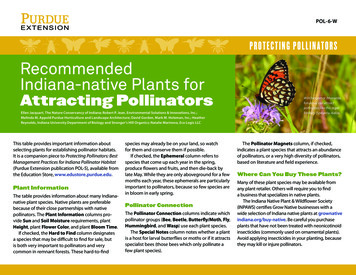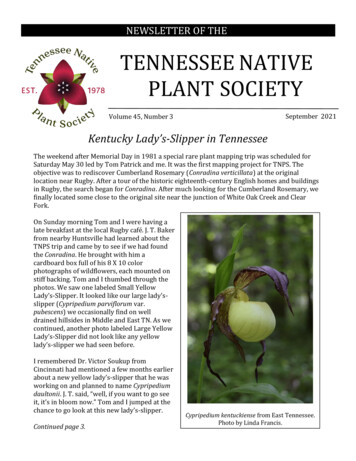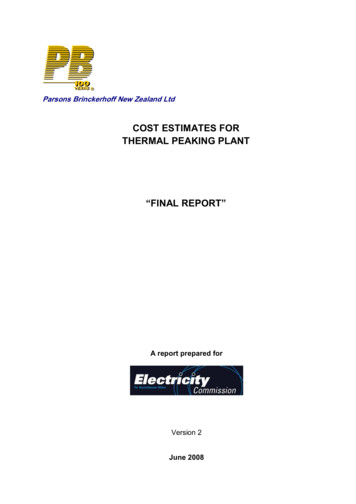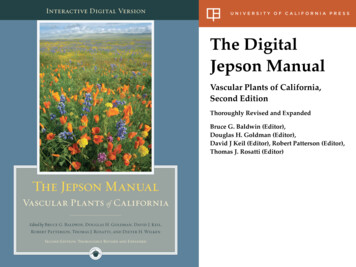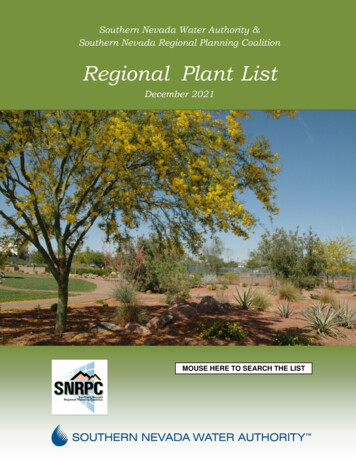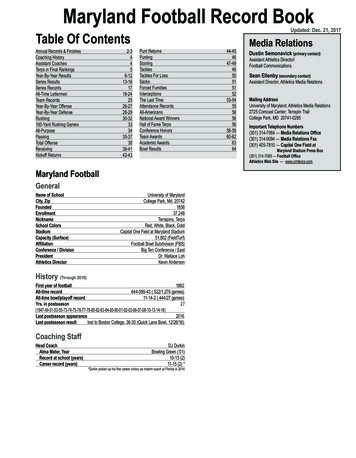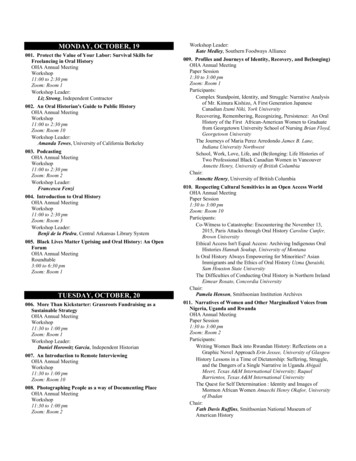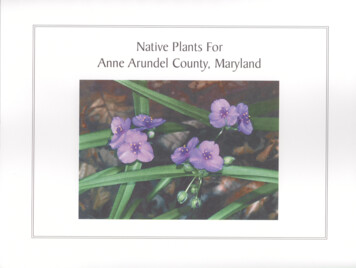
Transcription
Native Plants for Anne Arundel CountyLight1MoistureBloom PeriodScientific NameCommon Name(s)FS PS SHW MDHeightFlower ColorFall ColorNotesGroundcover (Low-growing plant that spreads over the soil surface, helping to suppress weeds and prevent erosion)Asarum canadenseWild Ginger!Chrysogonum virginianumGreen-and-gold!Hepatica americana!"!Mitchella repensRound-lobed hepatica,LiverleafPartridgeberry!"!Sedum ternatumMountain Stonecrop!"!Uvularia sessilifoliaStraw nWhite to h-whiteMay-JunYellow!Berries food for upland birdsVine (Woody or herbaceous plant that can grow long and climb vertical surfaces using tendrils or holdfasts)Campsis radicansClematis virginianaLonicera sempervirensParthenocissus quinquefoliaTrumpet Vine,Trumpet CreeperVirgins Bower#Trumpet Honeysuckle,Coral HoneysuckleVirginia Creeper#Jul-SepOrangeJul-SepWhiteApr-JulCoral##!" !Attracts hummingbirds; erosioncontrolShowy flowersAttracts hummingbirds and butterfliesFast grower; crimson fall colorWhite/purpleFern or Fern Ally (Plant that has fronds, not leaves, and reproduces with spores, not seeds)Adiantum pedatumNorthern Maidenhair Fern!Asplenium platyneuronEbony Spleenwort!Athyrium asplenioides (A.filix-femina)Southern Lady Fern!Dryopteris marginalisMarginal Shield Fern!"Onoclea sensibilisSensitive Fern!"Osmunda cinnamomeaCinnamon Fern#!Osmunda regalisRoyal Fern#Polystichum acrostichoidesChristmas Fern!1-2'Delicate texture!1-1.5'Small; can tolerate more sun!1.5-3'Aggressive; easy to grow!1.5' !1-2'Groundcover in wet areas" !2-3'Tolerates full sun in shallow water!" !2-3'Tolerates full sun if kept moist!"!1.5-2'" EvergreenEvergreenDark, leathery foliageNarrow, upright
2LightMoistureBloom PeriodScientific NameCommon Name(s)FS PS SHW MDHeightFlower ColorFall ColorNotesGrass or Grass-like (Non-woody plant that grows from the base, not the tip, of the leaves)Andropogon gerardiiBig Bluestem#! Andropogon virginicusBroomsedge#!Carex strictaTussock Sedge#!Chasmanthium latifoliumJuncus effususSea Oats,Wild OatsSoft Rush#Panicum virgatumSwitchgrass#Schizachyrium scopariumLittle Bluestem#Scirpus cyperinusWoolgrass#Sorghastrum nutansIndiangrass#Spartina alterniflora# Spartina patensSalt Marsh Cordgrass,Smoth CordgrassSalt Meadow Hay#Typha angustifoliaNarrow-leaved CattailTypha latifoliaZizania aquatica!5'Jun-SepClump-forming; attractive foliage2'Aug-NovSeeds provide food for birds!1-3'May-AugEasy to grow; tolerates shade andmoist conditions!2-3'Jul-Sep !2-3'Jun-SepProvides bird cover in aquatic areas !3-6'Jul-OctTolerates brackish to salt water;seeds provide food for songbirds4'Aug-OctClump-forming; tolerates poor soil3-4'Aug-SepSeeds provide food for ducks andother marsh birds5-7'Aug-SepBeautiful seed heads; provides foodfor birds!2-5'Jul-SepTolerates salt and brackish water !1-3'Jul-SepCommon in coastal salt marshes# !10'Jun-JulModerately salt-tolerant; wildlife valueBroad-leaved Cattail# !5-7'May-JunTolerates brackish waterWild Rice# !6-10'Jun-SepFood for overwintering waterfowl !! !!Herbaceous (Perennial non-woody plant that dies back at the end of a growing season)#Acorus calamusSweet FlagAquilegia canadensisArisaema triphyllumWild Columbine,Eastern ColumbineJack-in-the-pulpitAsclepias incarnataSwamp Milkweed#Asclepias tuberosaButterflyweedAster novae-angliaeNew England Aster! !2-3'May-JulFoliage fragrant; resembles ngeMay-JunOrangeSep-OctVioletAttracts hummingbirds!" !2'!" !1'!!4'#!!3'#!!2'Caustic to most animalsAttracts butterfliesFlowers a source of nectar forbutterfliesFlowers visited by butterflies; seedheads attract birds
Light3MoistureBloom PeriodScientific NameHerbaceous (cont’d.)Common Name(s)FS PS SHBaptisia australisBlue False Indigo#Baptisia tinctoriaWild Indigo#Boltonia asteroidesBoltonia#Caltha palustrisMarsh Marigold#Chelone glabraTurtleheadCimicifuga racemosaCoreopsis verticillataSnakeroot,Fairy CandlesPink Coreopsis,Pink TickweedTickseedDicentra eximiaWild Bleeding HeartEupatorium fistulosumJoe-Pye WeedGeranium maculatumWild GeraniumHelianthus angustifoliusSwamp SunflowerHeuchera americanaHibiscus moscheutosAlumroot,CoralbellsRose Mallow#!Iris versicolorBlue Flag#!Liatris spicataGayfeather#Lobelia cardinalisCardinal Flower#!Lobelia siphiliticaGreat Blue Lobelia#!"Mertensia virginicaVirginia Bluebells!"Monarda didymaBeebalm#Monarda fistulosaWild BergamotPenstemon digitalisBeardtongueCoreopsis roseaW M!DHeight4'3'!! ! "#!#! 3’1-2'!3'!5'!1.5'2'"!1.5'!5'!2'!5'!1.5' !3-6' !3' !3' !3' !3'!1'!!3'#!!4'#!!2'#!"# !"Flower ColorNotesFall ight llowApr-JunPale green/ edAug-OctBlueMar-AprPink turning blueJul-SepRedJul-AugPink to purpleJun-JulWill tolerate poor and clay soilTolerant of poor soilFlowers nectar source for butterfliesForms clumpsAttracts hummingbirdsExcellent woodland plantSeed eaten by songbirdsTolerant of poor soilNative to mountain regions; prefersrich, moist soilFlowers visited by butterfliesLong bloom timeFlowers visited by butterflies; seedheads eaten by birdsLong-blooming; semi-evergreenMoisture tolerantFlowers visited by butterfliesFlowers a source of nectar tohummingbirds and butterfliesAttracts hummingbirdsPlant will become dormant in heat ofsummerFlowers visited by hummingbirds andbutterfliesAttracts hummingbirds and butterfliesTolerates poor drainageWhite4LightMoistureBloom Period
Scientific NameHerbaceous (cont’d.)Common Name(s)FS PS SHW MHeightPhlox divaricataBlue Phlox,Woodland Phlox!Phlox stoloniferaCreeping Phlox!Physostegia virginiana#Podophyllum peltatumObedient Plant,False DragonheadMay-applePontederia cordataPickerelweed#!Rudbeckia fulgidaEarly Coneflower#!!1.5'Rudbeckia hirtaBlack-eyed Susan#!!2'Solidago bicolorSilver Rod Goldenrod#Solidago rugosaWrinkle Leaf Goldenrod#Solidago sempervirensSeaside Goldenrod#Spigelia marilandicaIndian PinkTiarella cordifoliaFoamflowerTradescantia virginiana!"D"Flower r-MayWhiteJun-NovJun-NovJul-OctYellowJun-OctGold 3'Fall ColorNotesBecomes dormant in heat of summerafter flowering; interplant with aster orgoldenrodSpreads easily; allow large spaceShiny, green, umbrella-like leavesFood for waterfowlR. fulgida var. sullivantii 'Goldsturm'is attractive cultivarSeed heads eaten by birds.5-3' !!1-6'!6'!"!2'#!"!1'Spiderwort#!!2'Vernonia noveboracensisNew York Ironweed#!4'Veronica wAug-OctEvergreenYellowMay-JunRed with yellowApr-JunWhiteApr-JulBlue, purple-bluePurpleAug-OctMay-JunPurpleFlowers visited by butterflies; seedseaten by birdsSalt-tolerantFlowers attract hummingbirdsLong-bloomingAttracts butterfliesPrefers well-drained soilLow Shrub (Shrub that generally grows less than five feet tall)Amelanchier obovalisObovate Serviceberry#!Aronia melanocarpaBlack Chokeberry#!Comptonia peregrinaSweet Fern#!!3'Apr-MayYellow-greenEuonymus americanusStrawberry bush!!1.5-6.5'Gaylussacia baccataBlack Huckleberry!!1.5'May-JunGreenishMay-JunWhite to pink Mar-AprWhite/ pinkApr-JunWhite orpink-tingedDarkpurple-redWell-drained soil; purple-black fruit inMay-JuneTolerates wet to dry soil; pretty fallcolor ;good for wildlife blackberryfruit August to Octoberblackberry fruit August to OctoberWell-drained soil; fruit, 4-5 mm nuts inAugust; leaves aromatic on hot daysor when crushedCrimson fruit, scarlet seeds; good forwildlifeImportant for wildlife
Light5MoistureBloom PeriodScientific NameLow Shrub (cont’d.Common Name(s)FS PS SHW MDHeight!2-4'Apr-JunGreenish to purpleWell-drained soil; dark blue fruit;important for wildlife; wet soils inspring; dry in summerMay-JunRedWhite, pale pinkApr-MayWhiteWell-drained soil; leathery leavesWell-drained soil; fruit period Sep toOct; extremely salt-tolerantApr-MayWell-drained soil; very fragrant flowerGaylussacia frondosaDangleberry#! Lyonia marianaStagger-bush!"!.5-6.5'Prunus maritimaBeach Plum!!1-8'Rhododendron atlanticumDwarf Azalea,!!.5-1.5'#Coast AzaleaFlower ColorFall ColorNotesWhite, purple tingedRubus cuneifoliusSand Blackberry#!1-3'May-JunWell-drained soil; Black fruits inJul-AugSpiraea albaNarrow-leaved Meadow-sweet#!5'Spiraea latifoliaAmerican Meadow-sweet#!5'Vaccinium angustifoliumLate Lowbush Blueberry#!!.25-1'Vaccinium vacillansEarly Lowbush Blueberry#!!.5-1.5'Jun-SepWhiteJun-SepWhite or pinkishMay-JunRedWhite or pink-tingedApr-MayGreenish-white, reddishWell-drained soil; fruits mature bySeptember but persist into winterWell-drained soil; fruits mature in fallbut persist through winterGrows in poor soil conditions; bluefruit in July; good for wildlifeWell-drained soil; dark blue fruit opensin July and early August; leatheryleaf; good for wildlifeViburnum acerifoliumMaple-leaved Arrowwood#!!3-6.5'Apr-MayWell-drained soil; purplish-black fruitpersisting well into winter; good forwildlifeMar-MayWhite, purple-tingedAug-SepWhiteTolerates wet to dry soil; fruit, barkand foliage important for wildlifeThistle-like silky white fruit in lateautumn; only found along the Bay,rivers, and higher parts of saltmarshesJul-AugCreamy whiteJul-SepWhite/ pinkMay-JunWhiteVery fragrant flower; excellent sourceof nectar; small fruit head/seedVery fragrant flower; hairy, sphericalfruitImportant for wildlife; a much-usedornamental; reddish twigs in winterOrange, redand purpleCreamy-white, pinkishMedium Shrub (Shrub that generally grows between 5 and 15 feet tall)Aronia arbutifoliaRed Chokeberry# !1.5-13'Baccharis halimifoliaHigh-tide Bush,Sea Myrtle, Groundsel Tree# !10'Cephalanthus occidentalisButton Bush# !10'Clethra alnifoliaSweet Pepperbush,SummersweetSilky Dogwood,Red Willow, Silky Cornel !10'!3-10'Cornus amomum!#!"YellowOrange, redor purple
Light6MoistureBloom PeriodScientificNameMedium Shrub (cont’d.)Common Name(s)FS PS SHW MDHeightFlower ColorFall ColorNotesHamamelis virginianaWitch hazel#!!3-15'Sep-NovYellowYellowIlex glabraInkberry#!!3-10'May-JunEvergreenIlex laevigataWinterberry#!!10'White to creamMay-JulWhite to creamaromatic; good ornamental; importantWell-drained soil; bright, orange-redfruit; important for wildlife; deciduoushollyIlex verticillataWinterberry Holly,Black Alder#! !16'Jun-JulWestern Maryland native; red fruitpersistent through the winter;Important for wildlifeItea virginica#! !3-10'Leucothoe racemosaTassel-white,Virginia SweetspireFetterbush!13'Lindera benzoinSpicebush!!6.5-16'Lyonia ligustrinaMale-berry!!1.5-10'Well-drained soil; holly-like leaves;attractive fall colorCultivated for its glossy, dark greenleavesWell-drained soil; leaves arespicy-aromatic when crushed; redWell-drained soilMyrica ceriferaSouthern Wax Myrtle!13-16'May-JunRed to purpleWhiteMay-JunWhite, reenYellowish-greenMyrica pensylvanicaNorthern Bayberry!!8'Apr-MayYellowish-greenBluish-white, hard, waxy berries;aromatic berries, used in makingcandles; good for poor soil conditions;deciduous to partial evergreen;leathery leavesRhododendron canescensSweet Azalea!!3-10'Well-drained soilRhododendron periclymenoidesPink Azalea,Pinxterbloom Azalea! !3-10'Apr-MayWhite or pinkApr-MayPink to whiteRhododendron viscosumSwamp Azalea# !6.5-10'Rhus glabraSweet Sumac,Smooth sumacCommon Elderberry#!1.5-10'!6-12'Sambucus canadensis!##""!! " May-AugWhite, pinkJun-JulGreenishJun-JulWhiteDull yellowWell-drained soil; seeds, fruits andfoliage important for wildlife; beautifulautumn color and cold-resistant;fragrant, spider-shaped flowerExcellent source of nectar; highlyWell-drained soil; gray-white fruit;fragrant wax of berries used incandles; leathery leavesWell-drained soil; an excellentornamental; formerly RhododendronnudiflorumIntensely fragrant flowerRedRed, hairy fruit; rich fall color; good forwildlifeFruit juicy purplish to black; manybirds eat fruit; tolerates drought; fruitsat four years
Light7MoistureBloom PeriodScientific NameCommon Name(s)Tall Shrub (Shrub that generally grows taller than 15 feet)FS PS SHW MDHeightVaccinium corymbosumHighbush Blueberry#!!13'Vaccinium stamineumDeerberry#!!5-10'Viburnum dentatumSouthern Arrowwood#!!10'Viburnum nudumNaked Witherod#!!6.5-13'Viburnum recognitumSmooth Arrowwood#!!10'WhiteAralia spinosaDevil's Walking Stick#!!Ilex deciduaPossum Haw#!Kalmia latifoliaMountain Laurel!Rhus copallinaDwarf or Ginger Sumac#Rhus typhinaStaghorn Sumac#Viburnum prunifoliumBlack Haw#Fall ColorNotesApr-MayYellow or redWhite or pink-tingedApr-JunGreenish-white orMay-JunYellow or redCreamy whiteApr-MayRed toreddish-purpleWhite to creamMay-JunBlue to blue-black fruits; excellent forwildlife; these hybridize rather freelyWell-drained soil; good for wildlife39'Jun-AugwhiteBlack fruit (berry); seeds poisonous ifchewed by humans; excellent forwildlife!33'!10'Apr-MayWhite or creamMay-JulEvergreenPink/purple; whiteWell-drained soil; berries and foliageprovide food and shelter for wildlifeWell-drained soil; excellentornamental; foliage exceedinglypoisonous if eaten!20'Jul-SepGreenishJun-JulYellow-greenBright redOrange-redWell-drained soil; red, hairy fruit; goodfor wildlife; beautiful fall colorHairy, deep crimson-red fruit; brilliantfall color; may become invasive; goodfor wildlife33'!Flower ColorWell-drained soilWell-drained soil; thick, glossy greenleaf; blue-black fruit; good for wildlifeDark blue fruit; good for wildlife !26'Apr-MayWhiteReddishpurpleWell-drained soil; bluish-black fruitpersists through winter; wildlife !12-20'Mar-AprYellow, redIntolerant of dry soil !35-50'Apr-MayWhiteOrange toredBeautiful autumn color; blue-black fruitin fall; fruit valued by wildlife!39'Mar-AprYellow/copper-redBrown spotted fruit; flowers opengreenish-yellow, becoming deep red!35-50'Yellow - redApr - MayOrange, redSlow-growing; dense branching12-20,JunUnderstory Tree (Tree that generally grows 15 to 49 feet or higher)Alnus serrulataSmooth AlderAmelanchier canadensisCanadian Serviceberry,Shadbush, ShadblowServiceberryPaw PawAsimina trilobaCarpinus carolinianaCastanea pumila8American Hornbeam,Blue Beech, Musclewood,IronwoodChinquapin,Allegany Chinkapin, EasternChinquapin#!"#!"!LightMoistureChestnut family, but not assusceptible to blight; seed sweet
Bloom PeriodScientific NameCommon Name(s)FS PS SHW MDHeightFlower Color Fall ColorApr-MayPink to lavenderMay-JunYellowWhiteApr-MayScarlet -Jun!32-39'WhiteAprWhite!65'May-JunWhite or creamEvergreenWell-drained soil; bright red fruit onfemale plants; leathery leaves; goodOrnamental,Christmas ed soil; male bears yellowcone; female bears brown-violet fruit;good for wildlife; cedar odor thought tobe moth repellent; much-usedornamental!33'May-JulgreenWhite to creamWell-drained soil; strong lemon androse-scented flowers#!to 25'May-JunDarkred-purpleWild Crab#!20-26'WhiteApr-MayPinkWell-drained soil; red to purple fruitAugust to September; medium-greenleaves (spring)Well-drained soil; glossy dark-greenleaves; yellowish-green fruit; good ained soil; aromatic, dark green#! !30-60'Yellow, red#! !40-60'Red, orange,yellowFast growth; short-lived; invasive;weak woodMedium to fast growth; aggressive;good shade tree; red flower, fruit andleaf stalks; weak wood; beautiful fallcolorCercis canadensisEastern RedbudChionanthus virginicusWhite FringetreeCornus floridaFlowering DogwoodCrataegus crus-galliCockspur HawthornCrataegus viridisSouthern ThornIlex opacaAmerican Holly#Juniperus virginianaEastern Red Cedar#Magnolia virginianaSweetbay Magnolia#Prunus virginianaChoke CherryPyrus coronariaSassafras albidum##!!" !!Lovely spring colorSlow growth rate; songbirds eat fruit;Flowers drooping, profuseBright red berries eaten quickly bysongbirds; tree may be susceptible toanthracnose fungusOrange toredFruits bright red/orange, October andpersisting into winterTall Tree (Canopy tree that can grow 50 feet or higher)Acer negundoAcer rubrumBox elder,Ash Leaf Maple, ManitobaRed MapleScarlet Maple, Swamp Maple,Soft Mapleby roots9LightMoistureBloom Period
Scientific NameCommon Name(s)FS PS SHW MDHeightFlower ColorFall ColorNotesTall Tree (cont’d.)Acer saccharinumBetula nigraCarya cordiformisCarya glabraCarya ovataCarya pallidaCarya tomentosaCastanea dentataSilver Maple,Soft Maple, White Maple, RiverMapleRiver Birch,Red Birch, Black BirchBitternut Hickory,Swamp Hickory, Pignut,BitternutPignut Hickory,Sweet Pignut Hickory, SmoothBark HickoryShagbark Hickory,Scalybark Hickory, ShellbarkHickorySandbark Hickory,Pale HickoryMockernut Hickory,White Hickory, Mockernut,American Chestnut,#! !50-80'YellowFast growth; brittle branches; long,curving branches; popular shade tree#! !30-50-YellowFast growth; peeling bark; hard wood !60-80'YellowSlow growth; tall trunk; strong wood;broad crown; inedible nut !60-80'YellowSlow growth; strong wood; inedibleseed!70-100'BrownShaggy, rough bark; strong wood,edible nut60-90'Slow growth; edible seed; strongwood; uncommon; sandy soilSlow growth; strong wood; long-lived;edible nutLarge massive trunk; edible nuts;prized wood; devastated by chestnutblight; more resistant cultivarsavailable##!####!Celtis occidentalisHackberry,Sugarberry, Nettletree#!Diospyros virginianaCommon Persimmon#! 50-75'Medium to fast growth; adaptableVery high wildlife value; Fruit edibleafter frost;, golden-yellow to orangefruitGreenish-yellowFagus grandifoliaAmerican Beech#!!50-100'Yellow/brownSlow-growing; strong wood;silvery-gray smooth bark; beech nutsFraxinus americanaWhite Ash#!!80'Yellow,maroonMedium to fast growth; strong woodFraxinus pennsylvanicaRed Ash, Swamp AshGreen Ash,#!!50-60'YellowFast growth; good shade treeJuglans nigraBlack Walnut,#!70-90'YellowMedium growth; valuable lumber; American Walnut, EasternLiquidambar styracifluaSweet Gum,Red Gum, Sap Gumedible nuts; do not plant near otherPlants due to toxins given off.#! !60-80'Yellow, redMedium to fast growth; widely adapted
Light10MoistureBloom PeriodScientific NameTall Tree (cont’d.)Common Name(s)FS PS SHLiriodendron tulipiferaYellow Poplar, Tulip TreeTulip Poplar,#Morus rubraRed Mulberry,Moral#Nyssa sylvaticaBlack Gum,Black Tupelo, Pepperidge,Sourgum, Swamp TupeloShortleaf Pine,Shortstraw Pine, SouthernYellow PinePitch Pine#Pinus echinataPinus rigidaW M!DHeightFlower ColorFall ColorNotes!70-120'YellowFast growth; large flower, large leaves!60'YellowMedium to fast growth; short trunk;edible berries; avoid white mulberry,which is on invasive list!30-60'RedSlow growth; glossy leaves,handsome shade nOpen crown; needles 3-4 1/2";moderately hard wood; abundant dropof needlesModerate to fast growth; needles 3-5";sometimes tufts of needles on thetrunk; hard wood; can tolerate dry,rocky soilsOpen, irregular crown; stout, crookedbranches, usually found near thecoast; tolerates flooding!70-90'EvergreenFast growth; long needles; fragrant;brittle wood!50-80'EvergreenMedium to fast growth; needles 1-3";winter-hardy; brittle wood !75-100'YellowFast-growing; white and brown peelingbark; large leaves; hard wood!100'YellowFast growth; relatively shortlived; softwood80'YellowFast growth, narrow crown, soft wood40-60'Yellow/ redFast growth; white flowers; valuablewood; leaves poisonous to livestock! Pinus serotinaPond Pine,Marsh Pine, Pocosin Pine# Pinus taedaLoblolly Pine,Old Field Pine, North CarolinaPine, Bull Pine, Rosemary Pine# Pinus virginianaVirginia Pine,Scrub Pine, Jersey Pine#Platanus occidentalisAmerican Sycamore,American Planetree#Populus deltoidesEastern Cottonwood,Carolina Poplar, SouthernCottonwood# Populus heterophyllaSwamp Cottonwood,Swamp Poplar, BlackCottonwood, Downy Poplar# Prunus serotinaBlack Cherry,Wild Cherry, Rum Cherry#!!
11Scientific NameCommon Name[s]Tall Tree[Canopy tree that can grow 50 feet or higher]Quercus albaQuercus bicolorQuercus borealisQuercus coccineaQuercus falcataQuercus marilandicaQuercus michauxiiWhite Oak,Stave OakSwamp White Oak,Swamp OakNorthern Red Oak,Red Oak, Gray OakScarlet Oak,Red Oak, Black OakSouthern Red Oak,Spanish Oak, Swamp Red OakBlack Jack Oak,Jack OakSwamp Chestnut Oak,Basket Oak, Cow OakLightFS PS SH##!!Notes80-100'Red60-70'Red/ brownSlow to medium growth; strong wood;classic oak with stout branchesSlow to medium growth; narrowcrown; strong woodMedium to fast growth' dense foliage;handsome shade tree; rare in 50'!# Pin Oak,Swamp Oak, Spanish Oak#Quercus phellosWillow Oak,Pin Oak, Peach OakChestnut Oak,Rock Chestnut Oak, Rock OakPost Oak,Iron Oak#!#!Quercus stellata Fall Color#Quercus palustrisQuercus prinusMoistureW M DHeight !60-80'Yellow/brownRed/ brown!60-80'RedMedium growth rate; straight trunk;horizontal branches; slender pin-liketwigs; strong wood!80-100'Red!60-80'Yellow/orangeBrownMedium to slow growth; classic oakwith stout branches; strong woodSlow to medium growth; chestnut-likeleaves; tolerates sandy or rocky soilSlow growth; dense crown; hard wood;used as posts, as wood is slow todecay#!Quercus velutinaBlack Oak,Yellow Bark Oak, QuercitronOak#!50-60'Red/ brownRobinia pseudoacaciaBlack Locust,#!40-80'YellowSalix nigraBlack Willow,Swamp Willow#!40-80'! Medium growth rate; good shade tree;tolerates poor soil; strong woodMedium to slow growth; large opencrown; good shade tree; strong woodSlow growth; open crown; hard wood;sandy or clay soilMedium to fast growth; compactcrown; chestnut-like leaves;uncommon on coastal plainMedium to fast growth; openspreading crown; good for sandy orclay hillsidestimber; spreads shoots fromFast growth; short-lived; durableLocust, Yellow Locustunderground roots; good honey plants;Flowers poisonous if eaten bylivestockFast growth; dense foliage; may havemore than one trunk; soft wood; goodshade tree; tolerates flooding
Eupatorium fistulosum Joe-Pye Weed # ! 5' Jul-Sep Flowers visited by butterflies Pink Geranium maculatum Wild Geranium!" ! 2' Apr-Jul Long bloom time Lavender Helianthus angustifolius Swamp Sunflower # ! 5' Aug-Oct Flowers visited by butterflies; seed Yellow heads eaten by birds Heuchera americana Alumroot,!" ! 1.5' Apr-Jun Long-blooming; semi .
